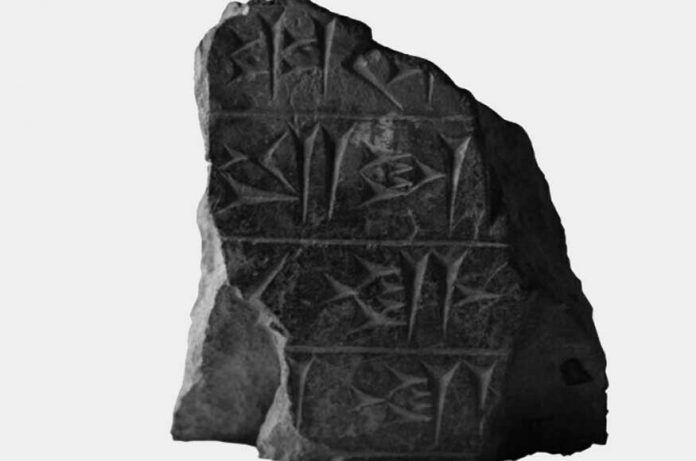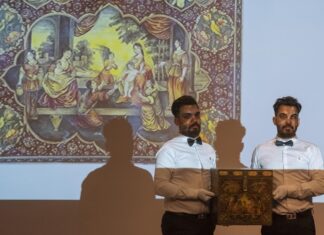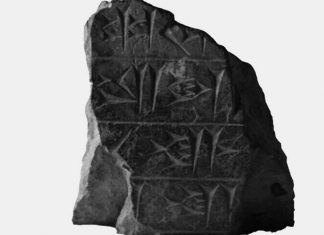By Kayhan Life Staff
Experts at the Takhte Jamshid World Heritage’s Research Center for Paleography — the study of historical writing — have discovered a limestone tablet written in cuneiform inside the archives of the which dates back to the reign of the Achaemenid King Xerxes I (486-465 BC) and is in the Elamite language.
The Achaemenid Dynasty was the first Persian Empire and ruled ancient Iran from 700 to 330 BC. The Elamite civilization flourished in the Iranian plateau between 3,200 and 539 BC.
[aesop_image img=”https://kayhanlife.com/wp-content/uploads/2022/02/sang.jpg” panorama=”off” credit=”KL./” align=”center” lightbox=”on” captionsrc=”custom” captionposition=”left” revealfx=”off” overlay_revealfx=”off”]
“Researchers discovered that passages in the text were from the Xerxes I inscription, known as the XPI tablet, which is in the Elamite language,” Hamid Fadaei, the director of Takhte Jamshid World Heritage, said. “The Takhte Jamshid World Heritage Research Center for Paleography, set up to restudy the tablet, will soon publish its findings on ancient languages, historical writings, and cuneiform tablets.”
Soheil Delshad, a philologist (expert in ancient languages) and an adviser to the Takhte Jamshid World Heritage Research Center for Paleography, noted that archeologists discovered the Persian language version of the tablet on Jan. 24, 1967 at a site located 1,700 meters north of the Persepolis Plateau.
“Badrolzaman Gharib [1929-2020], a professor of ancient languages at Shiraz University, studied and published her findings on this copy of [the tablet],” Mr. Delshad said. “A large segment of the inscription is a copy of the tablets on two sides of the tomb of the Achaemenid King Darius I [522-486 BC] in Naghsh-e Rostam [12 kilometers northwest of Persepolis]. Originally, [German archeologist Ernst] Herzfeld [1879-1948] discovered several segments of the tablets.”
“The Persian language copy of the inscriptions was one of the first Achaemenid tablets Iranian archeologists studied,” Delshad explained. “After nearly 55 years, Iranian researchers will soon publish their findings on the Elamite language copy of the inscription.”
According to Delshad, the Takhte Jamshid World Heritage holds the most extensive collection of ancient artifacts from Elamite civilization, the Achaemenid Empire, and subsequent kingdoms, including many cuneiform tablets discovered in Naghsh-e Rostam and other parts of the Persepolis Plateau.
Persepolis (Takht-e Jamshid), the ceremonial capital of the Achaemenid Empire, has been on the list of the United Nations National, Scientific, and Cultural Organization (UNESCO) World Heritage Site since 1979. The Islamic Republic has failed to protect, repair, and maintain Persepolis and many other historical and national heritage sites in the past four decades. Authorities have ignored Persepolis completely since the outbreak of the coronavirus. They have made no efforts to stop and reverse extensive lichen damage to limestone structures.
In an interview with the Iranian Labor News Agency (ILNA) on the subject of conserving historical and heritage sites, Hamid Fadaei said: “We could repair none of the structures if it were not for the material that Italian restorers gave us. We do not have the equipment and material to restore, repair, and maintain these sites. We also cannot pay salaries and fees to continue the work.”
Criminals who destroy ancient tablets believe they hide buried treasures, but do not realize that these are gravestones, recording the life and achievements of historical figures. Fadaei noted that the tablets are part of Iran’s economic and linguistic heritage. If these tablets, which are part of Iran’s national heritage, are not repaired, restored, and preserved, they will be lost forever.
The Iranian government’s annual budget allocates significantly greater funds to The Supreme Council of Seminaries, the Seminaries Service Center, the Coordination Council for Promoting Islam, the Supreme Culture of Islamic Revolution, and the Islamic Republic of Iran Broadcasting (IRIB) than the Ministry of Cultural Heritage, Handicrafts and Tourism and on restoring, conserving and protecting national and historic sites.






